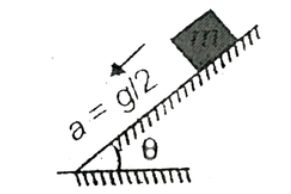If the inclination of an inclined plane is 30∘, a block of mass m kept at rest on the surface of the plane, will just slide down. If the inclination is raised to 45∘ what will be the acceleration of the body ?
To solve the problem, we need to analyze the forces acting on the block on the inclined plane at two different angles: 30 degrees and 45 degrees.
1. Identify Forces on the Block:
- When the block is on an inclined plane, the forces acting on it are:
- The gravitational force (weight) acting downwards: Fg=mg
- The normal force N acting perpendicular to the surface of the incline.
- The frictional force Ff acting opposite to the direction of motion.
2. Break Down the Gravitational Force:
- The gravitational force can be resolved into two components:
- Parallel to the incline: F∥=mgsinθ
- Perpendicular to the incline: F_{\perpendicular} = mg \cos \theta
3. Determine the Coefficient of Friction at 30 Degrees:
- At θ=30∘, the block is at the verge of sliding down, meaning the forces are balanced:
mgsin(30∘)=Ff
- The frictional force can be expressed as:
Ff=μN=μmgcos(30∘)
- Setting these equal gives:
mgsin(30∘)=μmgcos(30∘)
- Canceling mg from both sides (assuming m≠0):
sin(30∘)=μcos(30∘)
- Substituting the values:
12=μ⋅√32
- Solving for μ:
μ=1√3≈0.577
4. Calculate the Acceleration at 45 Degrees:
- Now, consider the case when the incline is raised to 45∘:
F∥=mgsin(45∘)=mg⋅√22
F_{\perpendicular} = mg \cos(45^\circ) = mg \cdot \frac{\sqrt{2}}{2}
- The frictional force at 45∘ is:
Ff=μN=μmgcos(45∘)=1√3⋅mg⋅√22
- The net force acting on the block is:
Fnet=F∥−Ff=mg⋅√22−1√3⋅mg⋅√22
- Factoring out mg⋅√22:
Fnet=mg⋅√22(1−1√3)
- Using Newton's second law Fnet=ma:
ma=mg⋅√22(1−1√3)
- Canceling m from both sides:
a=g⋅√22(1−1√3)
- Substituting g=9.8m/s2:
a=9.8⋅√22(1−1√3)
5. Final Calculation:
- Calculate the numerical value:
a≈9.8⋅0.7071⋅(1−0.5774)
a≈9.8⋅0.7071⋅0.4226≈2.93m/s2
Final Answer:
The acceleration of the body when the inclination is raised to 45∘ is approximately 2.93m/s2.
- When the block is on an inclined plane, the forces acting on it are:
- The gravitational force (weight) acting downwards: Fg=mg
- The normal force N acting perpendicular to the surface of the incline.
- The frictional force Ff acting opposite to the direction of motion.
- The gravitational force can be resolved into two components:
- Parallel to the incline: F∥=mgsinθ
- Perpendicular to the incline: F_{\perpendicular} = mg \cos \theta
- At θ=30∘, the block is at the verge of sliding down, meaning the forces are balanced:
mgsin(30∘)=Ff
- The frictional force can be expressed as:
Ff=μN=μmgcos(30∘)
- Setting these equal gives:
mgsin(30∘)=μmgcos(30∘)
- Canceling mg from both sides (assuming m≠0):
sin(30∘)=μcos(30∘)
- Substituting the values:
12=μ⋅√32
- Solving for μ:
μ=1√3≈0.577
- Now, consider the case when the incline is raised to 45∘:
F∥=mgsin(45∘)=mg⋅√22
F_{\perpendicular} = mg \cos(45^\circ) = mg \cdot \frac{\sqrt{2}}{2}
- The frictional force at 45∘ is:
Ff=μN=μmgcos(45∘)=1√3⋅mg⋅√22
- The net force acting on the block is:
Fnet=F∥−Ff=mg⋅√22−1√3⋅mg⋅√22
- Factoring out mg⋅√22:
Fnet=mg⋅√22(1−1√3)
- Using Newton's second law Fnet=ma:
ma=mg⋅√22(1−1√3)
- Canceling m from both sides:
a=g⋅√22(1−1√3)
- Substituting g=9.8m/s2:
a=9.8⋅√22(1−1√3)
- Calculate the numerical value:
a≈9.8⋅0.7071⋅(1−0.5774)
a≈9.8⋅0.7071⋅0.4226≈2.93m/s2
The acceleration of the body when the inclination is raised to 45∘ is approximately 2.93m/s2.
Topper's Solved these Questions
- BOOK - ICSECHAPTER - FRICTIONEXERCISE - Additional solved examples9videos
FRICTION
- BOOK - ICSECHAPTER - FRICTIONEXERCISE - Conceptual short answer questions with answer9videos
FRICTION
- BOOK - ICSECHAPTER - DYNAMICSEXERCISE - SHORT ANSWER QUESTIONS WITH ANSWERS12videos
DYNAMICS
- BOOK - ICSECHAPTER - GRAVITATIONEXERCISE - FROM THE HUBBLE TELESCOP2videos
GRAVITATION
Similar Questions
A wooden block is placed on an inclined plane. The block just begins to slide down when the angle of the inclination is increased to 45°. What is the coefficient of the friction?
View SolutionA cylinder is rolling down on a inclined plane of inclination60∘. What is iths acceleration?
View SolutionA block of mass 5 kg is at rest on a rough inclined surface. If angle of inclination of plane is 60∘, then force applied by it on block is
View SolutionA block of mass m slides down a rough inclined plane with an acceleration g2
 View Solution
View SolutionA cylinder rolls down an inclined plane of inclination 30∘, the acceleration of cylinder is
View SolutionA body weighing 20kg just slides down a rough inclined plane that rises 5 in 12. What is the coefficient of friction ?
View SolutionA block slides down an inclined plane that makes an angle θ with the horizontal. If the coefficient of kinetic friction is μ, find the acceleration of the block.
View SolutionAn ice cube is kept on an inclined plane of angle 30∘. The coefficient to kinetic friction between the block and incline plane is the 1/√3. What is the acceleration of the block ?
View SolutionA block slides down a frictionless, inclined plane that makes a 30∘ angle with the horizontal. Find the acceleration of this block.
View SolutionThe force required just to move a body up an inclined plane is double the force required just to prevent the body sliding down. If the coefficient of friction is 0.25, what is the angle of inclination of the plane ?
View Solution

